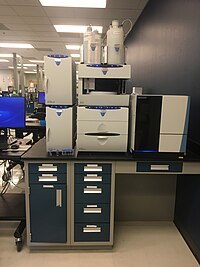Ion chromatography

Imagine you have a bunch of different colored beads that you want to sort out. You could use a machine that separates beads by color, right? Now imagine instead of beads you have tiny particles called ions that are too small for you to see. Ion chromatography is like that machine that sorts beads, but for separating ions!
In ion chromatography, we use a special liquid called a mobile phase that moves through a tube (like a straw). Inside that tube is a special material called a stationary phase that is like a filter that catches and separates different types of ions.
As the mobile phase moves through the tube, the different types of ions get caught on the stationary phase and separate into different groups. We can then measure the amount of each type of ion in each group to see what's in our sample.
Think of it like sorting M&M's by color. The M&M's represent the ions and the color sorter represents the chromatography machine. We pour the M&M's into the color sorter, and it separates them into piles by color. Then, we count how many M&M's are in each pile to figure out how many of each color we have.
In scientific terms, ion chromatography is a technique used to separate and measure different ions in a sample by using a mobile phase and a stationary phase. It is a powerful tool for analyzing water, food, medicine, and other substances for things like contaminants, nutrients, and other important compounds.
In ion chromatography, we use a special liquid called a mobile phase that moves through a tube (like a straw). Inside that tube is a special material called a stationary phase that is like a filter that catches and separates different types of ions.
As the mobile phase moves through the tube, the different types of ions get caught on the stationary phase and separate into different groups. We can then measure the amount of each type of ion in each group to see what's in our sample.
Think of it like sorting M&M's by color. The M&M's represent the ions and the color sorter represents the chromatography machine. We pour the M&M's into the color sorter, and it separates them into piles by color. Then, we count how many M&M's are in each pile to figure out how many of each color we have.
In scientific terms, ion chromatography is a technique used to separate and measure different ions in a sample by using a mobile phase and a stationary phase. It is a powerful tool for analyzing water, food, medicine, and other substances for things like contaminants, nutrients, and other important compounds.
Related topics others have asked about:
